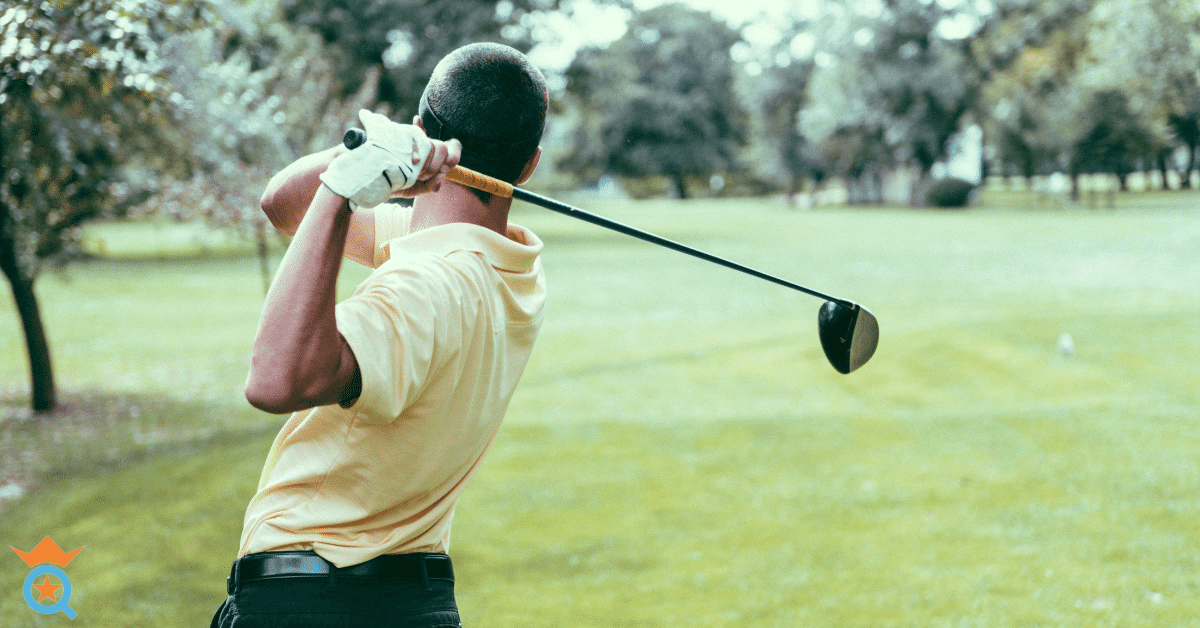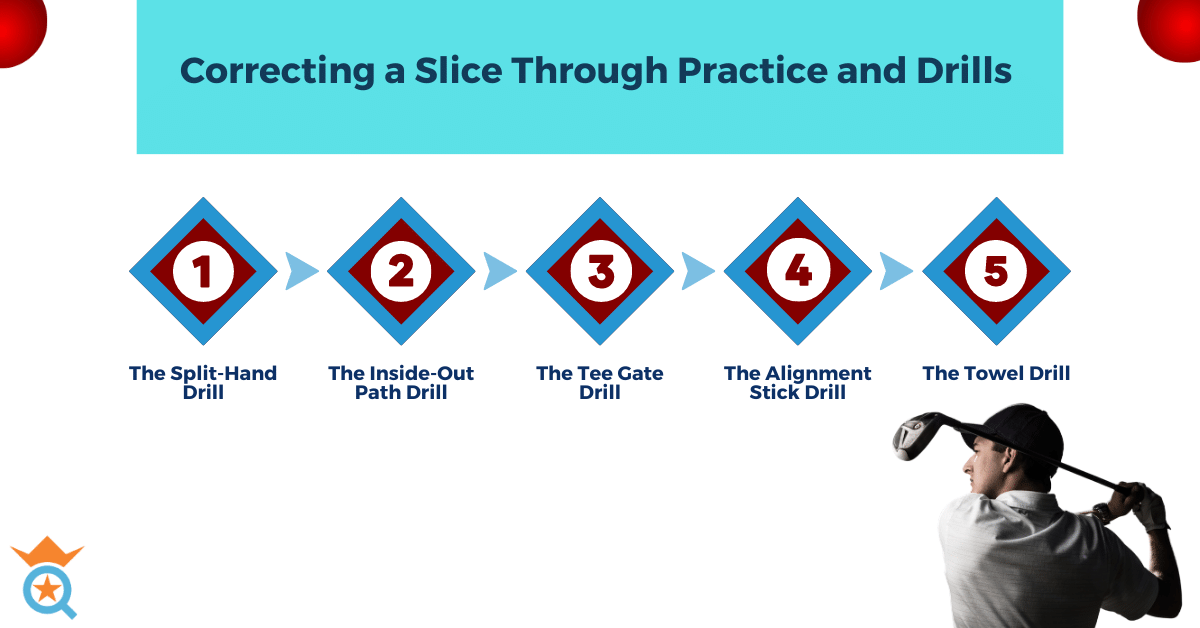Imagine stepping up to the tee, feeling the energy and excitement of a perfect day on the golf course. However, that excitement can quickly turn to frustration when faced with the all-too-common challenge of a golf slice. This pesky problem can throw your game off course, and conquering it begins with understanding the cause before diving into solutions.
In this article, we will unlock your golfing potential by sharing practical tips and techniques to fix a golf slice, using the wisdom of my years in personal development and incorporating essential golf concepts. Together, we'll transform your game, empower you to overcome this obstacle and reignite your passion for this beautiful sport.
Are you ready to take control of your golf swing and unleash the golfer within? Let's get started!
Why do you slice in golf? (Causes)
Understanding the root cause of a golf slice is essential in finding the right solution. Two main factors contribute to a slice: an open clubface and an in-to-out swing plane. Let's explore these causes and how they impact your swing.
Open clubface
When the clubface is open at the point of impact with the ball, it causes the ball to start right off the target line (for right-handed golfers). This open position puts a clockwise spin on the ball, making it curve to the right during its flight. An open clubface can result from an improper grip, poor alignment, or incorrect wrist movement through the swing.
In-to-out swing plane
The swing plane refers to the path the clubhead travels on during the swing. An in-to-out swing plane occurs when the clubhead moves from inside the target line to outside the target line during the downswing. Combined with an open clubface, this swing path exacerbates the slice by generating even more side spin on the ball, causing it to curve more to the right.
It's important to differentiate a slice from a fade, as these two shot shapes have distinct characteristics. While a slice is generally considered a detrimental shot due to its severe curvature and loss of distance, a fade is a more controlled and intentional shot with a gentle left-to-right curve (for a right-handed golfer). Many skilled golfers, including professional players, prefer a fade as their go-to shot because it offers more accuracy and control.
Recognizing whether you're dealing with a slice or a fade is crucial in determining the appropriate adjustments needed to improve your swing and achieve the desired ball flight.

How to Help a Slice in Golf (General Tips)
Improving your golf slice requires adjusting your grip, clubface alignment, and swing plane. Here are some general tips to help you conquer the slice and elevate your golf game:
Proper golf grip
The grip plays a significant role in controlling the clubface during the swing. To fix a slice:
- Consider strengthening your grip.
- For right-handed golfers, rotate your left hand slightly clockwise, so you can see at least two knuckles on the back of your hand.
- Rotate your right hand clockwise so the V-shape formed by your thumb and forefinger points towards your right shoulder.
This firmer grip allows your wrists and arms to release and roll over more effectively during impact, increasing the likelihood of a square clubface.
Squaring up the clubface
Ensuring the clubface is square at impact is vital for a straighter ball flight. Focus on maintaining proper wrist movement throughout the swing and avoid over-rotating the clubface on the backswing. Try to feel the clubface rotating toward the target on the downswing so it's square or slightly closed at impact. This adjustment helps to counteract the open clubface that typically causes a slice.
Correct swing plane
An in-to-out swing plane can exacerbate a slice, so it's essential to maintain a proper swing plane. One way to achieve this is by visualizing a "swing gate" during practice swings. Imagine two vertical poles, one slightly outside the target line and the other slightly inside the target line. Your goal is to swing the clubhead between these poles, ensuring it stays on a neutral plane throughout the swing. Doing so will promote a more in-line impact, reducing the likelihood of a slice.
Implementing these general tips and being consistent in your practice will help you make significant strides in reducing and ultimately eliminating the slice from your golf game.

How to Fix a Slice With a Driver
Using a driver effectively to avoid a slice involves a combination of proper setup, alignment, and swing adjustments. Here are some specific tips to help you fix a slice with a driver:
- Ball position: When using a driver, position the ball slightly forward in your stance, aligning it with the inside of your front heel. This setup encourages a sweeping motion and helps you strike the ball with a square clubface or a slightly upward angle, which is ideal for reducing slice spin.
- Tee height: Tee the ball up higher so that half the ball is above the top line of the driver when the club is resting on the ground. This higher position promotes an upward angle of attack, reducing the tendency to slice.
- Proper alignment: Ensure your feet, hips, and shoulders are parallel to the target line at the address. Many golfers who struggle with a slice inadvertently aim left of the target, promoting an out-to-in swing path. Aligning your body correctly encourages a more neutral swing path, helping to reduce the slice.
- Weight shift: Focus on a smooth weight transfer from your back to your front foot during the downswing. This movement helps square up the clubface at impact and promotes a more neutral swing path.
- Swing tempo: Maintain a smooth and controlled swing tempo. Rushing the downswing can lead to an over-the-top move, which causes the golf club to travel on an out-to-in swing path, resulting in a slice.
- Release the club: Ensure your arms and hands fully release and rotate through impact. This release helps square up the clubface and minimizes the chances of an open clubface at impact, a common cause of a slice.
Remember that proper setup and alignment are crucial in fixing a slice with a driver. Be patient and consistent with your practice, focusing on implementing these tips and adjustments to see improvements in your driving performance and a reduction in your slice.

Golf Grip to Fix a Slice
Strengthening the grip can be a highly effective method to help fix a slice, as it facilitates better control over the clubface and allows for a more natural release through impact. A firmer grip encourages the hands and wrists to rotate correctly, ensuring the clubface squares up at the point of contact with the golf ball, which is crucial for reducing slice spin.
To adjust your grip to prevent slicing, follow these steps for right-handed golfers (reverse the instructions for left-handed golfers):
- Place your left hand on the club, rotating it slightly clockwise so you can see at least two knuckles on the back of your hand.
- Position your right hand on the grip, rotating it slightly clockwise so that the V-shape formed by your thumb and forefinger points towards your right shoulder.
This adjusted grip, often called a "strong" grip, promotes the proper release and roll-over of the hands and wrists during the swing. As you become accustomed to this new grip, you'll notice a significant improvement in your ability to square up the clubface at impact, helping to minimize the dreaded slice.
Correcting a Slice Through Practice and Drills
Correcting a slice requires consistent practice and targeted drills to address the common issues of swing plane and clubface alignment. Here are several drills and practice techniques that can help you reduce and eliminate a golf slice:
- The Split-Hand Drill: This drill promotes proper clubface rotation and release. Choke down on the club and separate your hands by a few inches. Make half-swings, focusing on rotating the clubface through impact. The split-hand position encourages your wrists to hinge and release correctly, helping to square the clubface.
- The Inside-Out Path Drill: Place a headcover or object outside your ball along the target line. The goal is to swing without hitting the headcover, promoting an inside-out swing path. This drill helps train a more neutral swing path, essential for eliminating a slice.
- The Tee Gate Drill: Set up two tees in the ground, one on the target line and another a few inches behind it, creating a small "gate." Practice swinging the clubhead through the gate without touching the tees. This drill helps improve your swing plane, ensuring a more in-line impact.
- The Alignment Stick Drill: Place an alignment stick on the ground, pointing at your target and another parallel along your toe line. Practice your swing, ensuring your clubhead moves along the target-aligned stick during the backswing and downswing. This drill promotes proper alignment and swing path, helping to reduce the slice.
- The Towel Drill: Tuck a small towel under your back armpit and keep it in place throughout your swing. This drill encourages connection between your upper body and arms, promoting a more unified and controlled swing, which aids in squaring the clubface at impact.
It's essential to be patient and consistent when practicing these drills. Regular practice will help you develop better swing habits and improve your swing plane and clubface alignment, leading to a significant reduction or elimination of the golf slice over time. Remember that progress takes time, and staying committed to these drills will eventually yield the desired results.

So, How to Reduce a Slice in Golf (Recap)
In summary, understanding the causes of a slice and implementing the proper techniques and drills are crucial steps in reducing and ultimately eliminating a golf slice. The main factors causing a golf slice are an open clubface and an in-to-out swing plane. It's important to differentiate between a slice and a fade, as the latter can be a helpful shot in certain situations.
To reduce a slice in golf, consider the following key points:
- Strengthen your grip to promote proper clubface rotation and release.
- Square up the clubface at address and impact.
- Correct your swing plane to ensure a more neutral path.
- Utilize targeted drills and practice techniques to improve your swing mechanics and clubface alignment.
Remember, persistence and patience are essential to improve your swing and reduce a golf slice. Consistently practicing the techniques and drills outlined in this article will improve your swing and overall game. Stay committed to the process, trust your ability to make positive changes, and enjoy the journey toward a more accurate and reliable golf swing.
Popularity of Golf
FAQs
How do you fix a golf slice in 5 minutes?
While it's challenging to fix a golf slice in just 5 minutes completely, you can progress by strengthening your grip, squaring the clubface, and practicing a few swings with an improved swing plane. Be patient and consistent in your practice.
What shaft is best to fix a slice?
To fix a slice, consider using a more flexible shaft. This can help promote better clubface rotation and release, leading to a squarer clubface at impact and reducing the chance of slicing.
Will a stiffer shaft fix my slice?
A stiffer shaft may not necessarily fix a slice. A more flexible shaft could be more beneficial, as it encourages better clubface rotation and release, leading to a squarer clubface at impact.
Does a firm golf grip fix a slice?
A firm golf grip can help fix a slice by promoting proper clubface rotation and release. Adjust your grip by rotating both hands slightly clockwise (for right-handed golfers) to encourage a squarer clubface at impact.
How do you hold a golf club to avoid slices?
To avoid slices, hold the golf club with a slightly firmer grip, ensuring that you can see at least two knuckles on your left hand (for right-handed golfers) and that the V-shape formed by your thumb and forefinger points towards your right shoulder.
How do you hit a golf ball straight and not slice it?
To hit a golf ball straight and not slice it, focus on a firmer grip, squaring the clubface at address and impact, and maintaining a neutral swing plane. Practice consistently and use targeted drills to reinforce good habits and improve your club path and clubface alignment.








